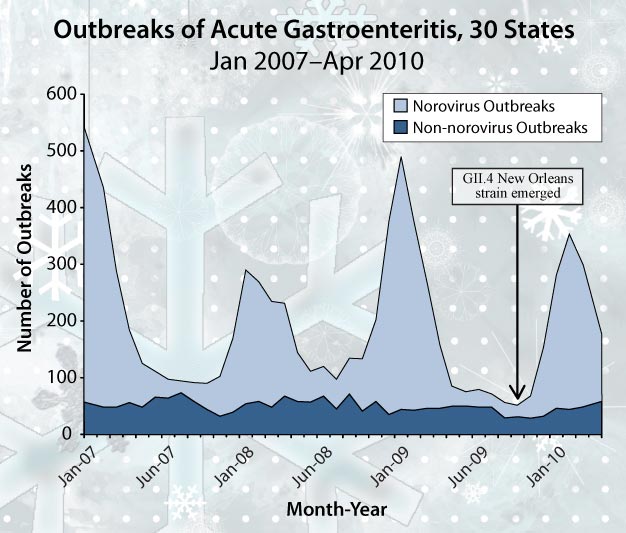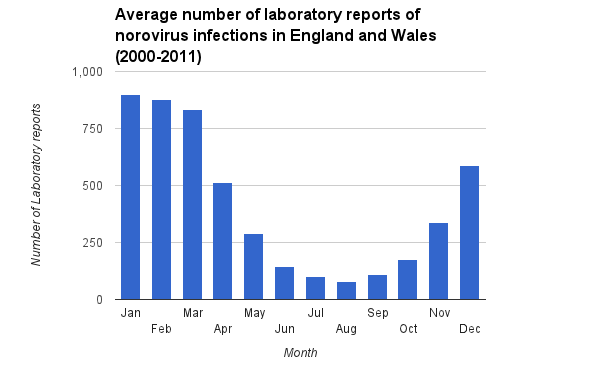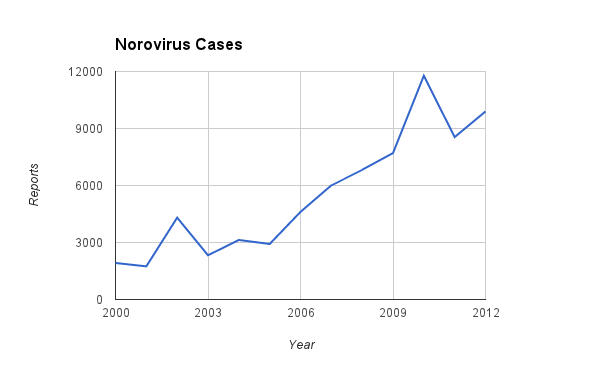Norovirus infection epidemiology and demographics
|
Norovirus infection Microchapters |
|
Diagnosis |
|---|
|
Treatment |
|
Case Studies |
|
Norovirus infection epidemiology and demographics On the Web |
|
American Roentgen Ray Society Images of Norovirus infection epidemiology and demographics |
|
Norovirus infection epidemiology and demographics in the news |
|
Risk calculators and risk factors for Norovirus infection epidemiology and demographics |
Editor-In-Chief: C. Michael Gibson, M.S., M.D. [1]
Epidemiology and Demographics
Norovirus is the leading cause of acute gastroenteritis in all age groups in the United States.
Each year, norovirus:
- Causes about 21 million cases of acute gastroenteritis
- Contributes to about 70,000 hospitalizations and 800 deaths, mostly among young children and older adults
Also, 16% of all acute gastroenteritis in the community is caused by norovirus, and 12% of acute gastroenteritis cases that get outpatient care are caused by norovirus.
People can get norovirus illness at any time during the year. But, it is most common in the winter. Also, there can be 50% more norovirus illness in years when there is a new strain of the virus going around.
Norovirus is the leading cause of foodborne illness in the United States.
It is responsible for:
- 58% of domestically-acquired foodborne illnesses
- 50% of foodborne disease outbreaks due to known agents.
Each year, it costs about $2 billion in the United States for healthcare and lost productivity from foodborne illness caused by norovirus.
Most foodborne outbreaks of norovirus illness are caused by eating food that was just contaminated by a food handler. However, widespread outbreaks of norovirus can also be caused by food, such as oysters, raspberries, and leafy greens, that were contaminated at their source.
Waterborne outbreaks of norovirus illness also occur in community settings. This is often caused by sewage contaminated wells and untreated recreational water.
Outbreaks
Most noroviruses that infect humans belong to genogroups GI and GII.[1] Noroviruses from Genogroup II, genotype 4 (abbreviated as GII.4) account for the majority of adult outbreaks of gastroenteritis and often sweep across the globe.[2] Recent examples include US95/96-US strain, associated with global outbreaks in the mid- to late-1990s, Farmington Hills virus associated with outbreaks in Europe and the United States in 2002 and in 2004, and Hunter virus was associated with outbreaks in Europe, Japan and Australasia. In 2006, there was another large increase in NoV infection around the globe.[3]
Most outbreaks of norovirus illness happen when infected people spread the virus to others. But, norovirus can also spread by consuming contaminated food or water and touching things that have the virus on them. Healthcare facilities, including nursing homes and hospitals, are the most commonly reported places for norovirus outbreaks in the United States and other industrialized countries. Nearly two-thirds of all norovirus outbreaks reported in the United States occur in long-term care facilities. Outbreaks of norovirus illness have also occurred in restaurants, cruise ships, schools, banquet halls, summer camps, and even at family dinners. These are all places where people often eat food handled or prepared by others. In fact, norovirus is the leading cause of illness from contaminated food in the United States. About 50% of all outbreaks of food-related illness are caused by norovirus. Foods that are commonly involved in outbreaks of norovirus illness are:
- Leafy greens (such as lettuce),
- Fresh fruits, and
- Shellfish (such as oysters).
However, any food that is served raw or handled after being cooked can get contaminated. Norovirus outbreaks have also been caused by contaminated water from sewage in wells and recreational water, such as pools.
Shown below is a graph that illustrates outbreaks of acute gastroenteritis in 30 states from January 2007 through April 2010. On average, there were nearly 3 times as many norovirus outbreaks (143 per month) as non-norovirus outbreaks (50 per month) and the number of norovirus outbreaks increased dramatically during the winter months. A new virus strain (GII.4 New Orleans) that first appeared in October 2009 did not lead to more outbreaks.

Shown below is a graph that illustrates the setting of 1,518 confirmed norovirus outbreaks in the U.S. from 2010 to 2011: Long-term Care Facility 59% (889 Outbreaks); Restaurants 8% (123 Outbreaks); Party & Event 7% (99 Outbreaks); Hospital 4% (65 Outbreaks); School 4% (64 Outbreaks); Cruise Ship 4% (55 Outbreaks); Other & Unknown 14% (223 Outbreaks).



Epidemiologic Criteria
Epidemiologic criteria have been proposed for use in determining whether an outbreak of gastroenteritis is of viral origin. Although quite specific, these criteria are not very sensitive, and therefore the possibility of a viral etiology should not be discarded if the criteria are not met. Kaplan's criteria for this purpose are as follows:
- A mean (or median) illness duration of 12 to 60 hours
- A mean (or median) incubation period of 24 to 48 hours
- More than 50% of people with vomiting
- No bacterial agent previously found
Developing Countries
Epidemiological data from developing countries about the importance of norovirus in pediatric diarrhea are limited. Recently, in Nicaragua, it has been observed that norovirus is responsible for 11% of the diarrhea cases occurring in children less than five years of age at community level and 15% of the moderate to severe cases requiring intravenous rehydration.[4]
In the Guangdong province of the People's Republic of China, the Provincial Health Department said on December 17, 2010, that it had confirmed 429 cases of norovirus infection in the November 2010 outbreak in Conghua, Guangzhou, but no one died from it.[5]
References
- ↑ Vinjé J, Green J, Lewis DC, Gallimore CI, Brown DW, Koopmans MP (2000). "Genetic polymorphism across regions of the three open reading frames of "Norwalk-like viruses"". Arch. Virol. 145 (2): 223–41. doi:10.1007/s007050050020. PMID 10752550.
- ↑ Noel J, Fankhauser RL, Ando T, Monroe SS, Glass RI (2000). "Identification of a distinct common strain of "Norwalk-like viruses" having a global distribution". J. Infect. Dis. 179 (6): 1334–44. doi:10.1086/314783. PMID 10228052.
- ↑ Tu ET, Bull RA, Greening GE, Hewitt J, Lyon MJ, Marshall JA, McIver CJ, Rawlinson WD, White PA (2008). "Epidemics of gastroenteritis during 2006 were associated with the spread of norovirus GII.4 variants 2006a and 2006b". Clin. Infect. Dis. 46 (3): 413–20. doi:10.1086/525259. PMID 18177226.
- ↑ Bucardo F, Nordgren J, Carlsson B, Paniagua M, Lindgren PE, Espinoza F, Svensson L., "Pediatric norovirus diarrhea in Nicaragua", J. Clin. Microbiology, 46: 8 (August 2008), pp. 2573–80.
- ↑ Norovirus infects 429 people in Guangzhou (CNTV reports)